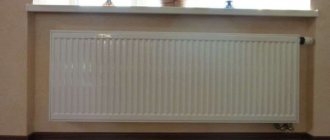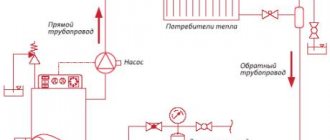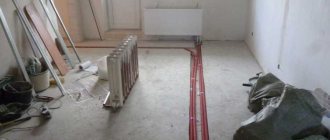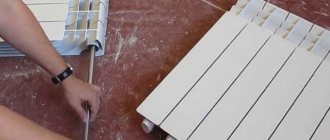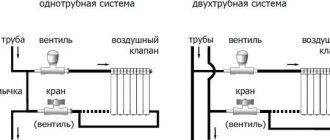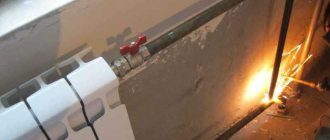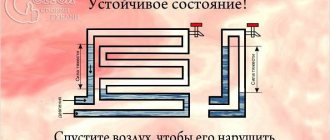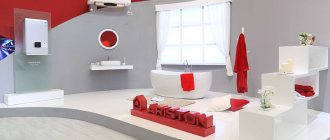Residents of apartments equipped with a central heating system often notice that from year to year the efficiency of heating the premises becomes less and less. They have to add additional heat sources - electric radiators, which heat efficiently, but locally. In addition, electricity bills significantly increase your overall utility bills.
There is another way out of the situation - using simple ways to increase the heat transfer of a central heating radiator.
There is no need to invite a specialist or purchase additional tools - everything can be done with your own hands, using available tools.
Typical reasons for decreased heat transfer
To understand the principle of operation of different methods of improving heat transfer, it is necessary to understand what factors have a decisive influence on the efficiency of the central heating system. These include:
- section manufacturing material;
- the area of the heating fabric, which should be selected depending on the area of the heated room;
- type of harness;
- carrier speed;
- initial heating level.
As an example, we provide data for radiators made of various materials.
| Radiators | Maximum working pressure (Bar) | Section heating power (W) | Water temperature (maximum values, C0) | Type of coolant |
| Cast iron | 6-9 | 80-160 | 150 | Water and others (depending on the boiler) |
| Bimetallic | 16-36 | 200 | 130 | Water, etc. |
| Aluminum | 6-25 | 190 | 130 | Water |
| Steel | 10-12 | 150 | 100-120 | Water, etc. |
Summarize
There are many ways to increase the heat output of heating radiators. Today we looked at only the main ones. However, it should be remembered that it is always easier to think through everything in advance, at the installation stage, than to put in a lot of effort later, without the confidence that the result will be significant. Unfortunately, in Russia everything is done at random. The final advice from the Homius.ru editors would be this: think about the future and spare no expense during installation. The financial resources saved today can turn into costs tomorrow that will be many times greater than your savings.
The most optimal option is that all the heat rises, which creates normal heat exchange
We hope that the information presented in today’s article was interesting and useful to our dear reader. Despite the fact that we tried to present everything in sufficient detail, you may still have questions about the material. In this case, ask them in the discussions below - the Homius.ru editors will be happy to answer them as quickly as possible. If you know a way to improve the heat transfer of radiators that is not reflected in today’s article, please share it with other home craftsmen - this information will be very useful. And finally, we suggest watching a short but quite informative video on today’s topic.
Factors that reduce the power of the heating system
A number of factors have a negative impact on the operation of heating radiators, reducing their power:
- air pockets - air must be released every time the system is started after a seasonal “rest”;
- internal contamination with solder, rust, calcium deposits;
- installation of external boxes made of materials with low thermal conductivity;
- frequent painting without removing the old paint layer;
- external contamination - dust, grease, etc.
However, utility workers rarely bother with preventive measures. It is also unrealistic to do the washing yourself. To carry out such manipulations, it is necessary to drain the carrier from the entire system (even in summer) and drive a special solution into it under pressure.
Important: we are talking about classic radiators made of cast iron. If you replace them with modern bimetallic ones, the heat transfer will increase several times. In addition, scale and rust will form less on the walls. It is difficult to carry out such work on your own; you need a master and draining the system.
Another reason for a decrease in heat transfer from a heating system is heat loss. Even at the construction stage, thermal engineering calculations are carried out and equipment is selected. The walls are insulated. If we are talking about houses where it is no longer possible to carry out additional insulation, it is worth paying attention to the quality of windows - they become the main source of heat loss. It is recommended to replace them with more modern ones.
Heat loss in the house
If you want to warm up in a cold room without resorting to complex manipulations with batteries, you can read about other effective ways to warm a room in our article on how to quickly warm a room without a heater - effective life hacks.
What is efficiency and how to calculate it
The heat output of heating devices, which include batteries or radiators, consists of a quantitative indicator of the heat that is transferred by the battery over a certain period of time and is measured in Watts. The process of heat transfer from batteries occurs as a result of processes known as convection, radiation and heat exchange. Any radiator uses these three types of heat transfer. The percentage of these types of heat transfer may vary among different types of batteries.
What will be the efficiency of heaters, in the vast majority of cases depends on the material from which they are made. Let's look at the advantages and disadvantages of radiators made from different types of materials.
- Cast iron has relatively low thermal conductivity, so batteries made from this material are not the best option. In addition, the small surface of these heating devices significantly reduces heat transfer and occurs due to radiation. Under normal apartment conditions, the power of a cast iron battery is no more than 60 W.
(See also: Which is the best heating radiator to choose)
Steel is slightly higher than cast iron. More active heat transfer occurs due to the presence of additional ribs, which increase the area of heat radiation. Heat transfer occurs as a result of convection, the power is approximately 100 W.
Aluminum has the highest thermal conductivity of all previous options, their power is about 200 W.
In addition, for the most efficient heating, you need to consider how much power you may need. When calculating the power of heating devices required for a room, the number of walls facing the street and windows is used. For every 10 m2 of floor with 1 external wall and window, about 1 kW of thermal power of the battery is required. If there are 2 external walls, then the required power is already 1.3 kW. (See also: Water-heated stoves)
The bottom connection is used if the heat-conducting pipes are hidden under the floor screed and does not exclude heat loss of up to 10% of the original value. A single-pipe connection is considered the least effective, since the loss of power of the heating device with this method can reach 45%.
Installing a reflective screen
For these purposes, foamed polyethylene is suitable, one of the sides of which is covered with a foil (reflective) layer. It is necessary to select the size of the screen - it must be larger than the area occupied by the radiator. The cut screen must be placed behind the radiator and secured to the wall with tape. The foil layer is directed towards the living space. How the screen works:
- the foam layer additionally insulates the wall under the window;
- the foil layer prevents heat from escaping, directing it back into the room.
Advice: it is not necessary to use this particular material; basalt slabs with an additional aluminum layer do a good job.
The method is effective. But he also has a number of opponents who believe that installing a screen leads to:
- dew point shift. You need to understand that the area of the installed screen is much smaller than the area of the entire wall behind the radiator. Therefore, he is simply unable to exert any significant influence and move the dew point. This indicator is influenced by several parameters at once: humidity inside and outside the room, wall material, type and method of installation of insulation, etc. One piece of polyethylene foam cannot have a more significant impact than all these factors combined;
- wall cooling and freezing. This argument can also be considered untenable precisely because of the small screen area.
Heat reflective screen for radiator
Ways to increase battery heat transfer
There are quite a lot of such methods, using several of them you can significantly increase the heat transfer of batteries.
Natural convention. This is the simplest way to increase heat transfer, based on an elementary natural law. The heated air rises to the top of the room, and after cooling it falls back down. To
The natural convention worked at full capacity; the batteries are best installed under the window. This will allow the cold air coming from the window to immediately heat up and rise to the top, rather than passing into the room unheated.
Freeing up space around the battery. This method will help the cold air heat up faster, since nothing will interfere with it. Placed furniture, thick textiles and various decorative decorations on the radiator significantly worsen and slow down the heating of the air.
If the batteries are open, the air circulation will not be disrupted and it will heat up quickly enough. Therefore, it is best to leave the space in front of the battery free.
Reflective screen. This screen is needed so that the battery does not heat the cold wall behind it, but directs all its heat into the room. The reflective screen helps with this; it allows you to direct the heat emanating from the battery in the right direction. Making such a screen is quite simple.
Can take either foil or any other material with a foil surface and attach it to the battery. The main thing to remember is that there must be a space of at least two centimeters between the material and the battery. This is necessary so that the air can circulate normally.
Electric fan. Installing such a device will improve air circulation, thereby speeding up the process of heating the air. This method is very effective and makes it possible to increase the temperature in the room by several degrees in a short time.
The main thing to remember is that the electrical appliance itself can overheat, so you need to turn it on only under supervision and not for a long time.
To ensure that the heat transfer of the battery does not deteriorate, it is necessary to regularly carry out wet cleaning. Dust significantly impairs the heat transfer of heating devices and pollutes indoor air.
Also, before the start of the heating season, you need to bleed the air from the batteries, as it greatly impairs the heating ability. This procedure should be carried out only after water has been released through the pipes. This reading of the battery will improve its heat transfer.
Such methods are quite effective; thanks to their use, the heat transfer of batteries can be significantly improved and the temperature in the room can be increased by several degrees. If these methods do not help in any way, then most likely you will still have to change the batteries to new and more powerful ones.
But the replacement cannot be carried out without the help of specialists, since this process requires certain knowledge and skills.
It also entails a considerable amount of material costs, so it is better not to replace and install new batteries yourself; it is better to turn to knowledgeable and experienced professionals.
Aluminum casing and painting
To increase the room temperature, you can increase the heated surface area using an aluminum casing. It is placed on the radiator and is heated by the hot sections, thereby increasing heat transfer. The casing also plays a decorative role. Such a device is inexpensive, but its effect is significant.
Surprisingly, the color in which the heating radiators are painted also plays a role. We are used to painting them in light colors, mostly white. But darker shades have significantly higher heat transfer. For example, heating sections painted brown have a higher heat transfer rate than white ones by about 25%.
Aluminum casing for radiators
Painting the radiator dark
Another opinion that wanders on the Internet is that painting the battery black or brown increases heat transfer by radiation. In most cases, such judgments are based on the physical concept of an “absolute black body,” which absorbs and emits the most. All this applies to the heating battery. Those painted with light paint emit less radiation than those painted with dark paint. Let's figure out how much.
A little physics. According to the Stefan-Boltzmann law, the radiation of an absolutely black body is proportional to the absolute temperature to the 4th power.
R(T) = σ × T4, where
σ = 5.67·10-8 W/(m2K4) - Stefan-Boltzmann constant.
Real bodies are classified as “gray”. For real “gray”, its emissivity ε must be taken into account. The battery itself absorbs IR radiation from the room, and the textbooks provide a corresponding formula, which includes the temperatures of both the battery and the room (in Kelvin to the 4th power). It is easy to show that if you heat a battery from 20°C to 40 degrees, its radiation will increase 81 times. The calculation (approximate, of course) shows the following. Let a battery with an area of 1 sq. m is painted with brown oil paint (for it ε ≈ 0.8). Let the water temperature in it be 70°C, and the room temperature - 20°C. Then the IR radiation power of such a battery will be 300 W. Not so little! A battery painted with matte black (not glossy!) paint will heat up even more. And if the paint is white, the radiation power will be lower. But aesthetic considerations usually take precedence, and batteries (open) are usually painted with light colors.
Black radiators can also be freely found on sale Comment Sergei Kharitonov Leading engineer for heating, ventilation and air conditioning LLC GC Spetsstroy Ask a question “Physics directly proves the effectiveness of painting a radiator in dark colors, but all this applies to ideal operating conditions. Let me remind you that in conventional water batteries convective heat transfer predominates and color does not affect it in any way. In addition, you need to be confident in the quality of the entire heating system. If 30°C comes into your radiator, then don’t paint, it won’t do any good. Well, don’t forget about the aesthetic component. Are you ready to contemplate black “coffins” every day for the sake of a few tens of extra watts?”
Conclusion: effective, but requires ideal operating conditions.
Improving convection by increasing air circulation
The laws of physics say that increasing the speed of air flow in a room contributes to faster heating. For these purposes, a fan is suitable, which must be installed so that the air is directed from the heated sections to the center of the room.
Tip: It is not necessary to purchase special fans. If you have an old computer at home, a cooler from a block will do. It can be installed under a radiator so that the direction of warm air goes towards the center of the room. This will increase convection and the room will warm up much faster.
If the heating sections are mounted in such a way that they are located deep under the window sill (if it is large), additional holes can be made in it. This will help air circulation, it will not accumulate and stagnate in the niche. Of course, this applies to situations where the window sill is made of plastic or wood. It will be difficult to drill a concrete or granite product yourself. The hole can be closed with decorative plugs.
Tip: using even the most beautiful decorative curtains significantly reduces the heat transfer from the heating radiator, causing warm air to stagnate in the niche. It is recommended to curtain windows as little as possible.
Experimental data.
First day of the experiment.
All graphs show temperature changes from 8:00 am to 12:00 pm.
The coolant temperature is 42ºС.
The graph shows that the system worked more efficiently while the temperature difference between the air and the battery was large. When the difference decreased, the system stabilized.
The air temperature in the center of the room at a height of 65 cm from the floor rose from 15ºС to 20ºС in 9 hours.
Subsequently, the temperature rose another 0.5ºС.
The fan power consumption was 35.2 Watts.
When, during the experiment, I left my room into the corridor, I immediately felt the temperature difference, because by that time I had already taken off my warm clothes.
I went to the barn and brought out another fan. This fan was not equipped with a power switch, so I connected it through a homemade triac regulator, the design of which is described in detail here.
Well, life has become better, life has become more fun!
Second day of the experiment.
In the morning I again measured the coolant temperature, as well as the air temperature in the room. All values remained unchanged, including the outside temperature.
No changes in temperature were noticed during the day.
Third day of the experiment.
The coolant temperature increased by one degree and amounted to 43ºС.
The temperature outside dropped and reached -15ºС.
At the same time, the temperature in the room increased by another 0.5ºС and reached 21.5ºС.
Fourth day of the experiment.
The coolant temperature is still 43ºС.
The temperature outside in the morning is -15ºС.
The temperature in the room in the morning was 21.5ºС.
Since no significant changes in temperature were noted over the past 24 hours, I decided to increase the air flow and installed a second fan at 10.00.
After 10-15 minutes, the air temperature immediately increased by one degree, and then by another half a degree and reached 23ºС.
Let's go for a walk, I thought, and at 19.00 I turned on both fans at full power. The temperature increased by another degree in two hours and reached 24ºС.
System purging
Airing or clogging of radiators leads to a completely cold canvas or part of it. Purging the system will help. There are several methods, each of which will require additional equipment:
- hydraulic purging;
- pneumohydroimpulse;
- the use of chemical compounds or soda ash.
These types most often involve servicing the entire system. This seems to be the most effective, because central heating is a complex system of pipes and pipelines.
It is recommended to carry out a single collective cleaning, which will be much more effective than individual cleaning.
Ways to increase heat transfer
At the moment, there are several ways to increase the heat output from a heating system that has already been created and was in operation, but did not live up to your hopes:
- Installation of convectors. This design is made of a pipe with metal plates strung on it, either made by hand or factory-made.
- Painting the main pipeline black or another dark color. This method, despite its simplicity, is quite effective. In addition, the color can quite organically fit into the modern design of premises, unlike the recent past, when this was considered a necessary measure.
Note! Paint is only an additional method, which is relevant in rare cases, since the efficiency is too low to “admire” the black stripes.
- Installation of registers in the heating system. The register consists of several large diameter pipes connected to each other and with welded ends. Such designs include heated towel rails in the form of a coil with several loops.
- Rearrangement of radiators with the addition of sections. This option is the most expensive, but is also higher in efficiency than the others.
If you decide to add radiators, be sure to place them under the windows or next to the front door (as in the photo)
We recommend! Don't forget that installing additional insulating materials also allows you to increase heat transfer, reducing the loss of generated heat. However, it is only possible when constructing a residential building from the foundation, or when dismantling the facade.
Changing the radiator connection method
There are often situations when, after connecting and bleeding excess air from the system, half of the sections still remain barely warm compared to the other half. In this situation, the connection method should be blamed. This applies to media supply options both from below and from above - sections farthest from the entrance will have a lower media temperature.
For a one-way connection, it is rational to use special optimizers - for example, flow extenders.
Two-way connection is not an option - both upper and lower. It is also characterized by a temperature difference, only the bottom or top of the sections are colder.
The best option is a diagonal connection with top distribution. Changing the connection and pipe layout is not always possible. It is recommended to purchase and install radiators that have a special design of the internal space - they have an additional partition installed between the two parts of the canvas. Its purpose is to change the direction of the coolant in such a way as to warm up all sections without exception.
Diagonal diagram for connecting heating radiators
Changing the radiator connection seems to be the most effective way to increase heat transfer. Of course, it is better to plan such events at the stage of installing batteries. However, additional changes can be made later. In this case, you will not have to attach additional devices to the system.
How to install any radiators
The coolant in central heating has special impurities that negatively affect many radiator models. That's why they are not installed in apartments. In fact, to solve this problem, we need to make sure that instead of the thermal power plant coolant, we use our ordinary water.
For these purposes, you need to install a heat exchanger at the entrance of the central heating risers into the apartment.
A heat exchanger is a device that removes heat from one source and transfers it to another source. Simply put, this is our intermediary who will simply take heat from the thermal power plant and transfer it to our own heating system inside the apartment.
What are the benefits of a heat exchanger?
- Performs the function of a boiler by removing heat
- Allows you to create your own heating system inside the apartment with your own coolant and pressure.
- Allows you to implement any heating options
Using a heat exchanger also has its disadvantages:
- It gets clogged from time to time. Requires dismantling and washing
- In addition to the heat exchanger, it is necessary to install an expansion tank, pump and related fittings.
Having installed the heat exchanger, you can mount any radiator system: radiator, two-pipe and others. You can hide the pipes in a screed. You can use any pipe materials without worrying that they will become unusable. Any brand of radiator can be used.
General rules for improving heat transfer from heating radiators
In order not to encounter a decrease in the heat transfer of batteries in the future, it is worth thinking about this at the stage of installing radiators. The basic rules are:
- mandatory insulation of the wall behind the radiator, possible installation of a steel screen;
- installation of bimetallic batteries instead of cast iron ones;
- installation of taps at the inlet and outlet of the radiator (this will allow you, if necessary, to flush sections yourself or add additional ones without disconnecting and draining the entire system).
If you follow these simple rules during installation, it will subsequently be much easier to increase the temperature in the room without turning to specialists for help. And this is additional savings for the family budget.
Conclusion: how to make your apartment warmer
In fact, it is impossible to actually increase the amount of heat without changing the input parameters of the system (radiator material, its size, heating temperature). Using the above methods, there is a chance to use this heat more efficiently - completely, with maximum efficiency and optimal distribution in the apartment. For example, a screen will prevent thermal energy from being lost, and a fan will allow the warm air flow to spread more evenly.
If the apartment is cold, and this interferes with the normal life of the owners, more radical measures will have to be taken. These include:
- replacing old cast iron batteries with modern bimetallic radiators;
- “increasing” the number of sections on the battery;
- insulation of the wall behind the radiator and installation of a powerful steel screen.
When carrying out a major overhaul of the heating system, you need to remember: even the highest quality appliances need to be updated after 20–25 years, as their service life is coming to an end. It is worth choosing batteries from the most “advanced” materials of modern design - they are the most energy-intensive and will certainly help make the apartment warmer and more comfortable.
Reading time: 5 minutes No time?
The cold weather has arrived, the heating has been turned on, but it’s still cold at home? A situation familiar to many. The first thing that comes to mind is how to make the batteries work at 100%? In today's review, we decided to analyze which of the methods that can be found on the Internet actually help to increase the heat transfer of radiators, and which are fiction from a scientific and practical point of view. And a specially invited specialist will help us with this.
Read in the article
Registers
This was a very simple and cheap solution in situations where large areas needed to be heated. Although if we talk about the heat transfer of a pipe in such a register in comparison with an aluminum radiator, the difference in efficiency is staggering. Due to the larger area of the radiator heat exchanger and the thermal conductivity of aluminum, modern equipment is undoubtedly preferable. And externally the registers looked quite rough.
However, for their time registers were acceptable due to their cheapness and simplicity. It can be noted that the welds on them were very strong, and pipe clogging did not interfere with their functioning.
Prologue.
This year we are experiencing unprecedented frosts. In some areas of the republic, the air temperature dropped to -24ºС, which is an anomalous phenomenon for warm Moldova. I don’t have a thermometer hanging in my room, but I felt that my hand lying on the table began to freeze, and I had to put a piece of foam rubber under it.
We, in general, like the Amundsens, are already accustomed to the coolness, but yesterday the chairman of our condominium, while collecting signatures for an appeal to the heat supplier, asked what the air temperature was in our apartment. It is unlikely that the heat supplier will increase the temperature of the coolant, but perhaps the chairman wants to demand a penalty under the pretext of providing poor-quality services.
Be that as it may, this event first prompted me to measure the air temperature in the apartment, and then to conduct this experiment.
Of course, to say that this experiment was unclean is to say nothing. There are too many variables that could affect the accuracy of the result, from the direction of the wind overboard to the activity of the computer running in the room being tested.
But the most important parameter, which at another time would not have allowed this experiment to be carried out at all, is the stability of the coolant temperature.
The fact is that in warmer periods of time, the temperature of the coolant is actively regulated during the day to save energy consumption. When the temperature outside is abnormal, all the valves open wide.
Small details.
To quickly and accurately measure the temperature of a steam heating battery, it is enough to apply a small amount of “KPT-8” thermal conductive paste to the sensor ball of a digital thermometer. During the measurement, the contact area should be covered with several layers of fabric or a layer of foam rubber.
The above experiment made me question the accuracy of my digital thermometer. To make sure his readings were correct, I compared them with the readings of a mercury thermometer. To do this, I immersed both thermometers in hot water to the same depth and monitored the readings as the water cooled.
Prolonged operation of fans immediately revealed the weak point of modern devices.
If the 1973 Penguin fan has a front sliding bearing equipped with an oil seal (the arrow marks the hole for filling the oil seal), which has allowed it to work for almost 40 years, then in a modern fan there is no trace of such an oil seal.
In addition, the Penguin has a spring that prevents longitudinal vibrations of the shaft. The new fan, after two days of operation, began to rattle, because due to the longitudinal runout of the shaft caused by the eccentricity of the propeller, one of the fluoroplastic gaskets quickly wore out.
To eliminate the longitudinal play, several ordinary and two thin-walled washers were needed, as well as a gasket cut from foam rubber.
First I disassembled the stator.
Then I put thin-walled washers and a gasket on the motor shaft, and used the remaining washers to increase the gap between the bearings.
To ensure any long-term operation of the fan, I cut out an oil seal from felt, and a seal plug from some nylon cover and pressed it all into the recess around the shaft. Naturally, I didn’t skimp on the oil either.
I started thinking about buying two dozen 120mm computer fans. I think if you install them directly between the battery sections, it should reduce noise and increase heat transfer efficiency.



